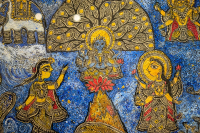Culture & Lifestyle
The story of handwritten magazines
Vidya Mandir Library in Baglung has archived several handwritten magazines from the 1950s and 60s.
Prakash Baral
In 1960, Prem Chota decided to publish a handwritten monthly magazine called ‘Saroj.’ It was quite a daunting task, but he approached it with optimism. He used to roam around nearby towns in Baglung looking for stories to put in the magazine. After collecting suitable stories, he wrote them on paper. Now, Chota is in his 80s. “After writing all night and preparing the magazine, I used to distribute it in public places and libraries, and I even kept it in some places for the general public to read,” he recalled.
These handwritten magazines are now available in Vidya Mandir Library, in Baglung Bazaar, in Baglung. “We used to work on an empty stomach to provide information to the public,” says Chota, “But now, with technology, passing the information is instant and easy,” For his contribution to literature, Chota has been honoured with ‘Mahakavi Satbarsiki Award’, ‘Trimurti Award’, and ‘Bhupi Memorial Award’.
Chota is the only living editor who used to work with handwritten magazines in Baglung. Before him, in 1951, a handwritten magazine had already been circulating in his town. After the establishment of democracy in 1981, Omkar Prasad Gauchan, originally from Mustang, published a magazine titled ‘Sahi Bato’ (The Right Way), which he wrote by hand. This was an essential step for education and awareness, says Jagannath Acharya, former principal of Vidya Mandir Secondary School. “Such handwritten articles are still preserved in the library because the development of literature began from such handwritten magazines,” said Acharya.
It was Omkar’s father, Om Prasad Gauchan, and Megh Kumar Baidya, who had jointly established Vidya Mandir Secondary School in Baglung during the early 1940s. Inside the school’s premises, they also founded a library named Vidya Mandir Pustakalaya. But this was during the Rana regime, and no one was allowed to establish an educational institution without their consent. So, they put up a board on the front of the school that read, ‘Domestic Industry’ so government officials wouldn’t raid the facility.
Today, many students—especially those studying history—visit the library to see such hand-written magazines. “For those who want to read books and handwritten newspapers from the Rana era onwards, this library serves as the centre,” said Ram Bahadur Thapa, the library chairman. “The digital age has erased the history of handwritten articles,” he adds. The library holds many handwritten magazines such as ‘Sahi Bato,’ ‘Muno,’ ‘Manjari,’ ‘Jyoti,’ and more. In the past, these magazines published news about politics, gold prices, business, literature, sports, and more.
Another handwritten magazine called ‘Manjari’, written by Shiv Kumar Pradhan, started publication in Baglung in 1957. Under Pradhan’s leadership, the team used to produce up to 100 copies in a single issue. Pradhan was also a prolific author who has published dozens of books in Nepali, English, and Sanskrit languages. Though he passed away four years ago, his work is still remembered by many.
Currently, Baglung has three daily newspapers, ten weekly newspapers, eleven radio stations, and one television channel. There are also several online platforms that provide news to people.
“When the term ‘handwritten magazine’ is mentioned, politicians and administrators of the country rush to the library to see the birth of literature,” said Mukeshchandra Rajbhandari, the former chairman of the library. “But we haven’t been able to give it the reach it deserves,”
The library has also digitised historical books and other reference materials using digital systems, according to Thapa. He mentioned that around 100,000 literary works have already been digitised. The founder of the library, Gauchan, has documented the modern history of Baglung as well. With the assistance of Megh Kumar Baidya, a technician, he has kept records in the library of various work in areas such as building construction, roads, drinking water, and market management.
A plan has been initiated to convert the 8,000 books in the library into electronic format so they can be read digitally. “As old newspapers and magazines are deteriorating because of the humidity, it is necessary to digitise them,” he said.




 5.15°C Kathmandu
5.15°C Kathmandu.jpg)















